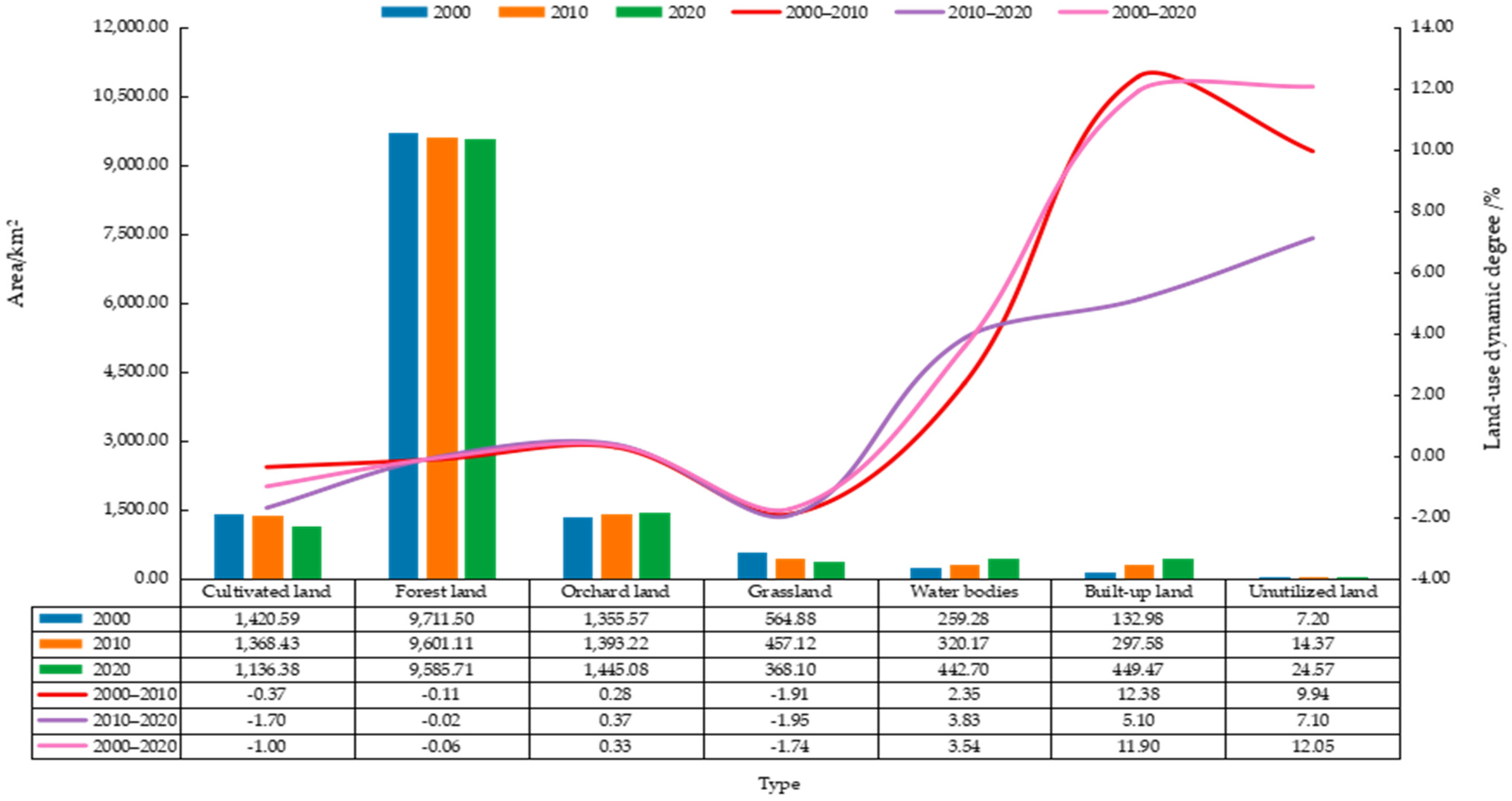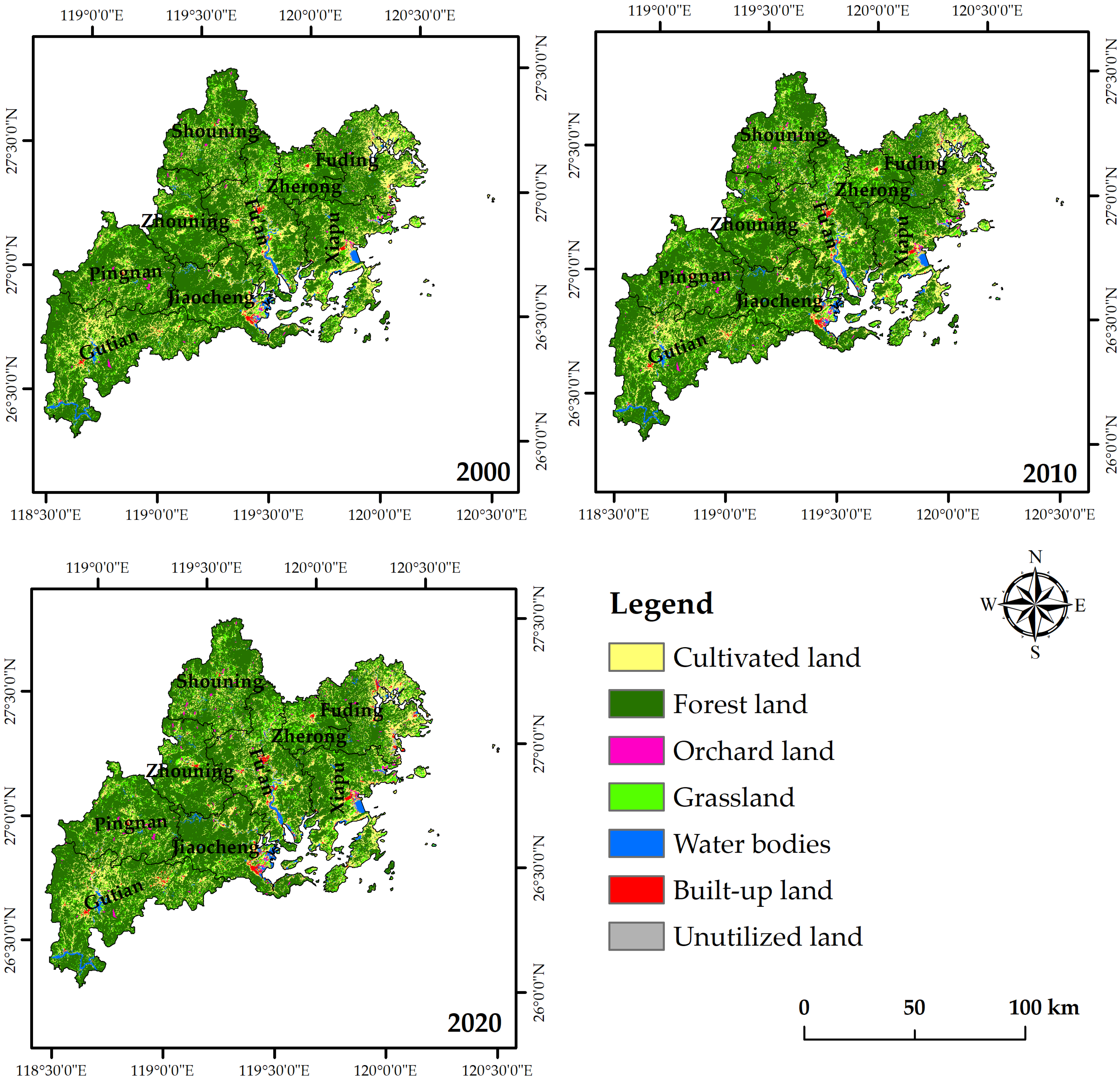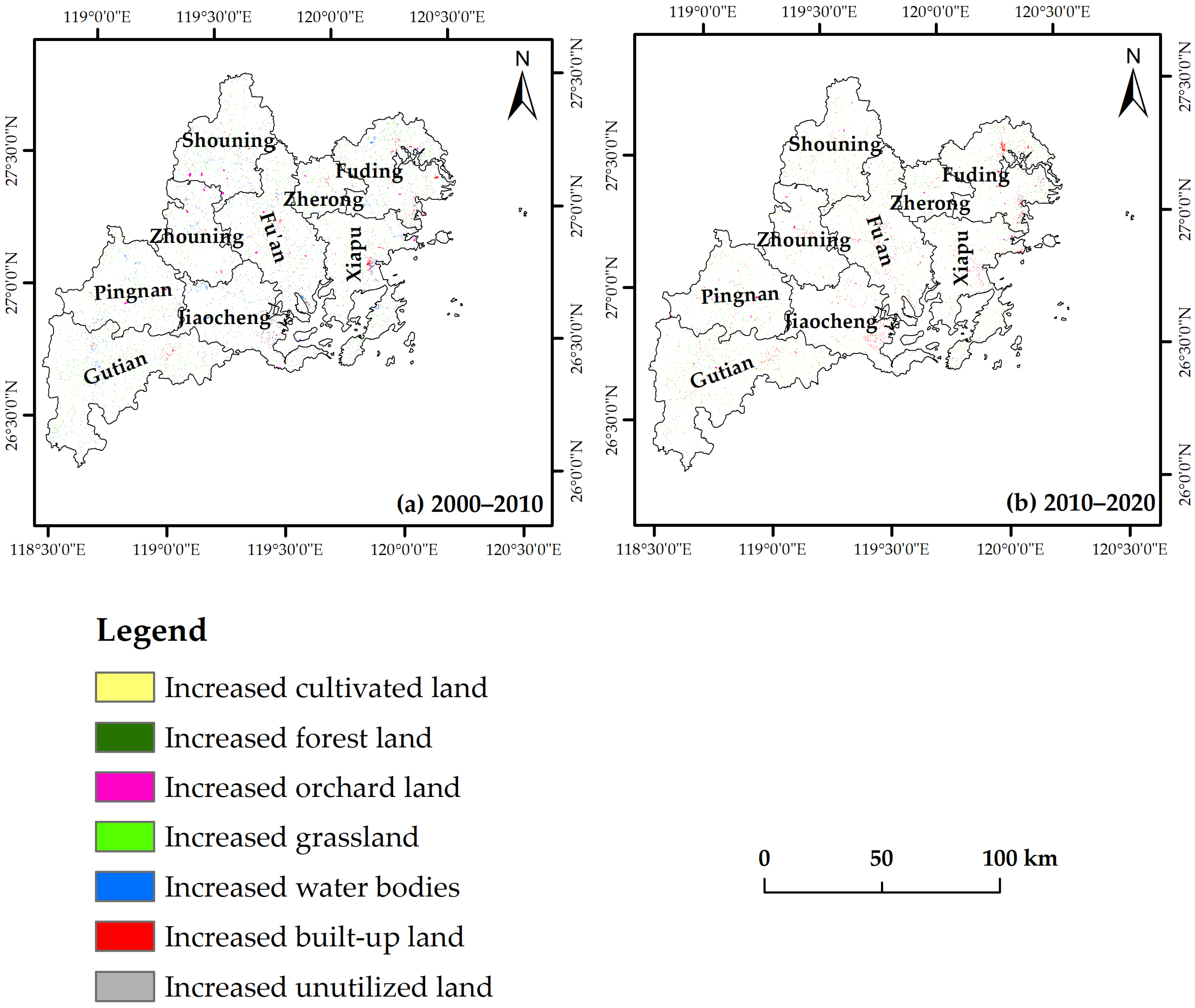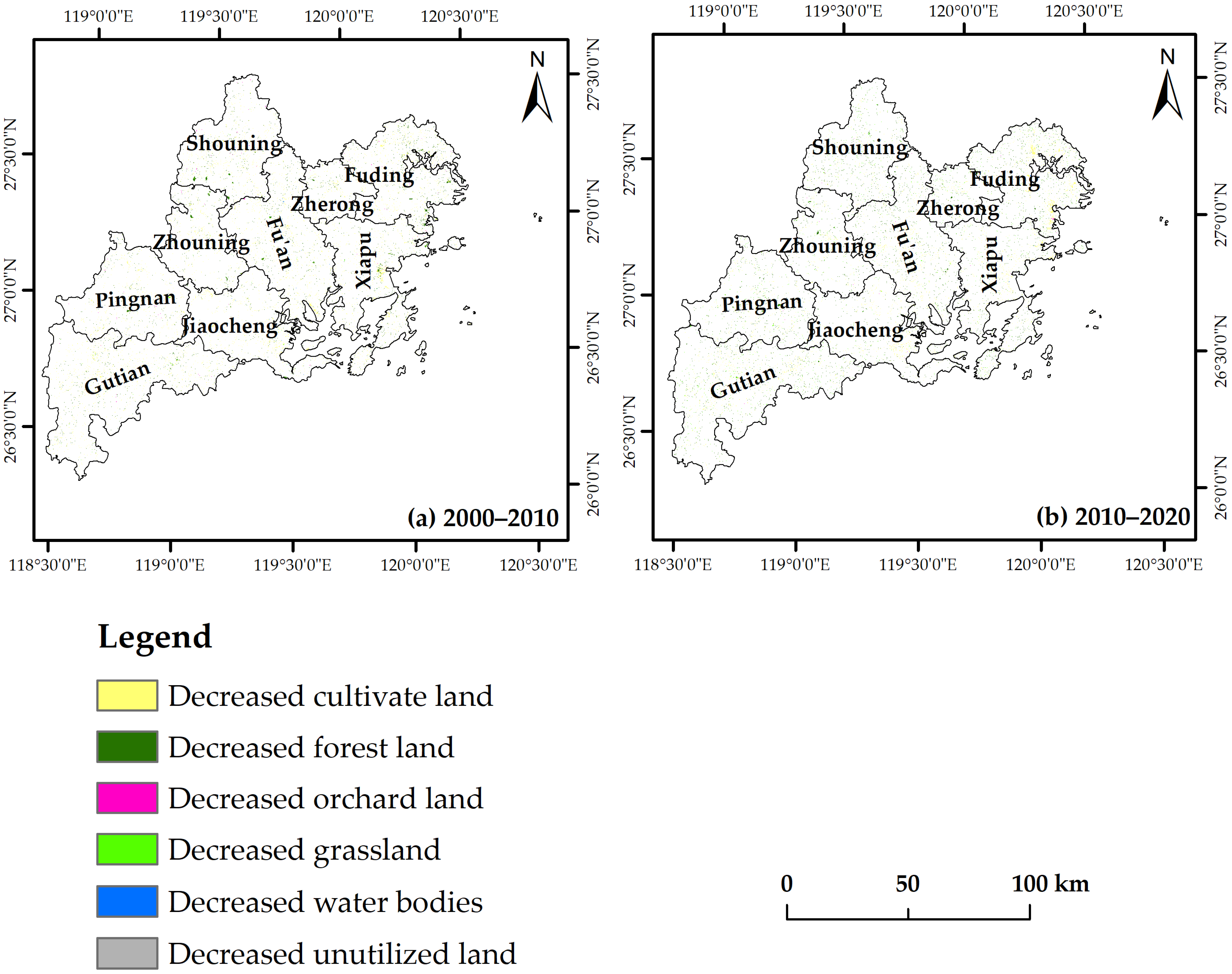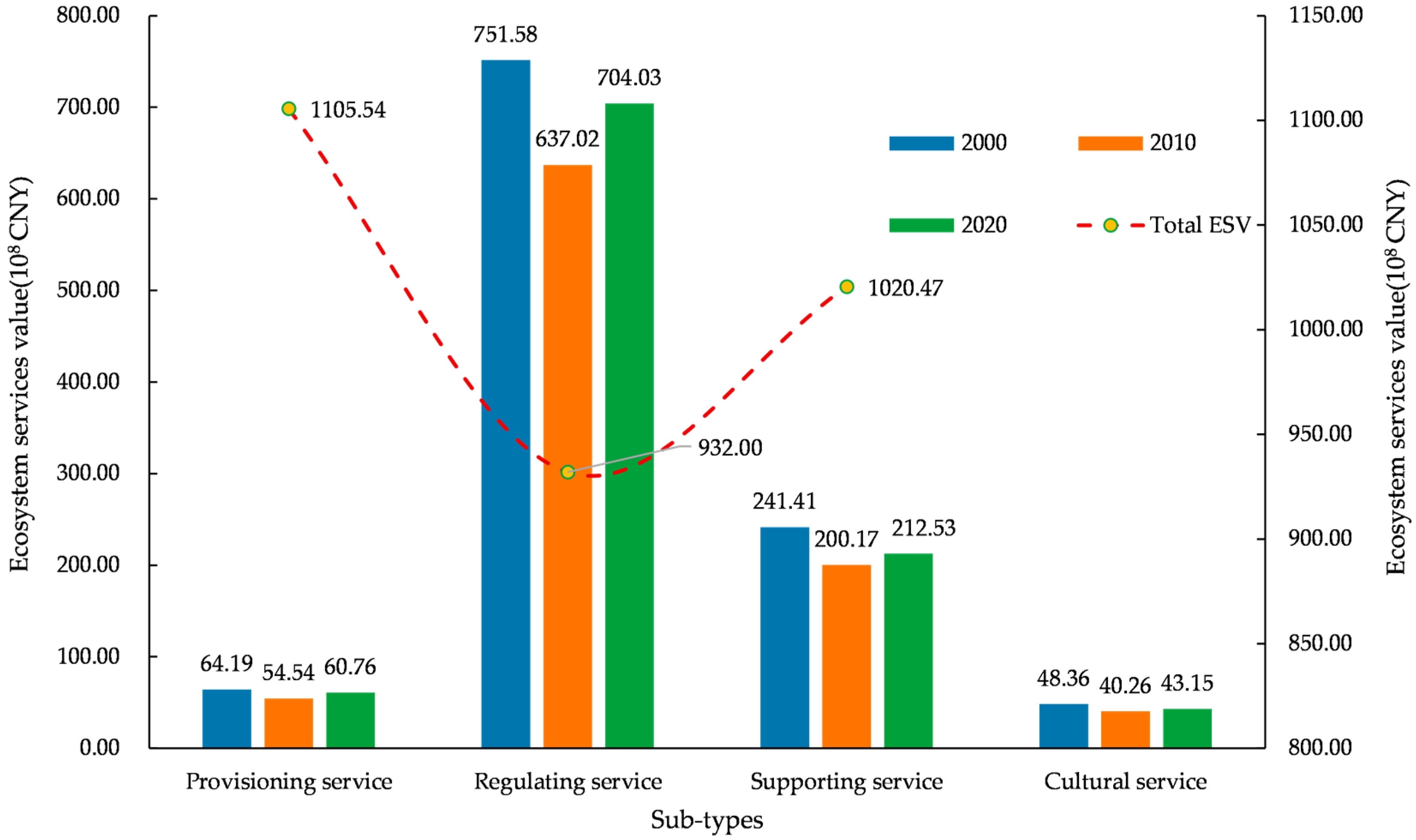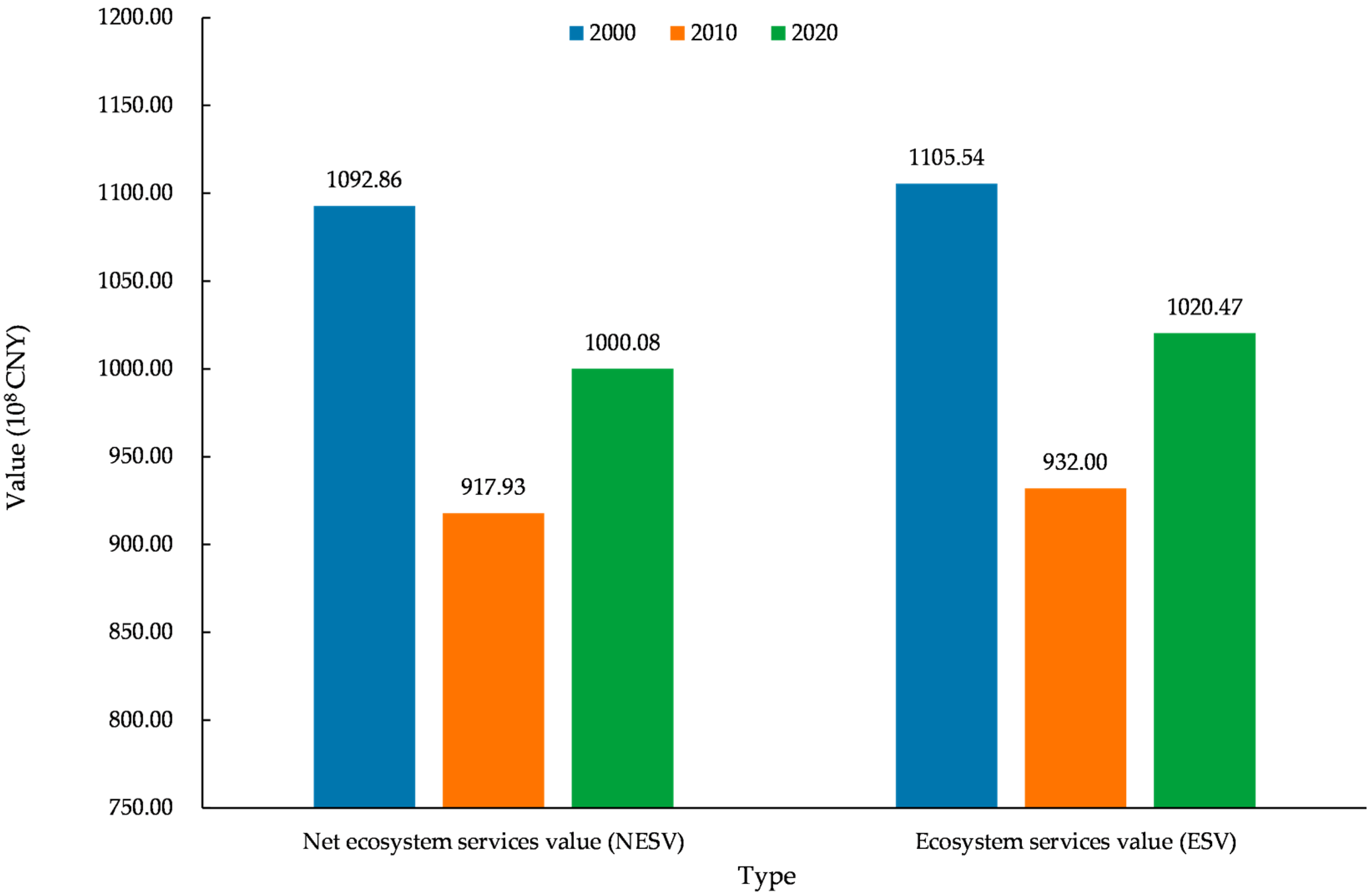1. Introduction
China’s rapid urbanization and industrialization processes have significantly accelerated land-use transitions (LUTs), making them a pivotal driver and integral component of global environmental change, thereby posing substantial threats to ecosystems. Ecosystem services (ESs) encompass the eco-environmental conditions and utilities vital for human survival, generated and sustained by ecosystems. These services encompass all benefits humans directly or indirectly derive from ecosystems [
1,
2,
3,
4]. The ESs approach is widely recognized as a promising avenue for achieving sustainable development goals [
5]. Sustainable development programs, by providing ecosystem services value (ESV), offer a balanced framework aligning economic and environmental agendas, thus constituting an optimal strategy for urban development [
6,
7].
Land-use transitions (LUTs) arise from the interaction between human socio-economic activities and the natural environment [
8]. Various land-use types possess distinct capacities to deliver diverse types, quantities, and qualities of ecosystem services. LUTs serve as primary drivers of ecosystem services and climate change, consequently rendering ecosystems vulnerable [
9,
10,
11]. Acting as a bridge between nature and society, ESs intricately connect LUTs with human well-being, thereby serving as a crucial nexus for regional ecological security and socio-economic development [
12,
13]. However, alongside urbanization, industrialization, and socio-economic development, certain unsustainable land-use patterns have inflicted severe damage on ecosystems [
14,
15,
16], significantly diminishing the regional ecosystem services value and impairing the capacity of ecosystems to provide essential services [
9,
17,
18]. Moreover, studies indicate that climate change directly impacts biological communities by altering temperature, precipitation, and other factors, further disrupting ecosystem services’ capacity [
19]. With the exacerbation of the conflict between eco-environment and socio-economic development, the pressing question arises: Can limited natural resources and fragile ecosystems sustain long-term socio-economic development worldwide? This emerges as a critical scientific challenge requiring urgent resolution.
Since the advent of industrial civilization, rapid economic development, unbridled resource consumption, and unchecked development have spawned a plethora of eco-environmental challenges, including ecosystem degradation, biodiversity loss, and the weakening of ecosystem services, thereby posing serious threats to human survival and development [
20,
21,
22]. Ecosystem services valuation serves as a crucial tool for assessing the efficacy of ecological protection and holds significant reference value for regional ecological compensation [
23,
24,
25,
26], ecological security pattern construction [
27], and ecological civilization construction [
28]. Hence, quantitatively examining the influence of LUTs on the ecosystem services value is imperative for coordinating regional sustainable development. The evaluation of the ecosystem services value (ESV) has emerged as a frontier and prominent issue since Costanza’s pioneering global ESV assessment in 1997 [
2]. Scholars have closely monitored this field, tracking dynamic changes in global ESV [
29,
30,
31,
32]. For instance, Ouyang et al. (1999) conducted an initial estimation of China’s terrestrial ESV [
33]; Xie et al. (2003) evaluated the ecological assets of the Qinghai-Tibet Plateau and established per-unit-area service value tables for terrestrial ecosystems in China, which were subsequently revised [
34], and then constantly revised the equivalent scale [
35]. Woldeyohannes et al. (2020) analyzed the impact of land-use dynamic changes on the ecosystem services value in the Abaya-Chamo basin in southern Ethiopia using local and global ecosystem services value coefficients [
36]. Additionally, scholars have extensively discussed how drastic land-use changes and climate change induce ecosystem degradation and affect the ecosystem services value [
19,
37,
38,
39,
40,
41].
Analysis of the existing academic literature reveals that many researchers have employed the ecosystem services valuation method proposed and refined by Costanza et al. (1997) and Xie et al. (2015) to assess ESs across various ecological units and spatio-temporal scales [
9]. This approach has yielded substantial findings and advanced the research on ecosystem services valuation, offering a valuable framework for our study. However, existing literature requires improvements in several key areas. Firstly, it is widely acknowledged that the evolutionary trajectory of land use influences changes in ESV. While many studies analyze the spatio-temporal patterns of land-use transitions (LUTs) using models such as the land-use dynamic degree model, CLUE-S model, and landscape pattern index, these methods only partially integrate spatial and temporal aspects. Consequently, LUTs results lack visual representation, and non-spatial attribute data are inadequately expressed in terms of spatial location. Therefore, there is a critical need for a spatio-temporal composite analysis method capable of visually and dynamically illustrating LUTs processes through mapping units. Geo-informatic Tupu was first proposed in 2000 by the Chinese scholar Chen shupeng [
42], who has since completed and improved the relevant aspects of the methodology by publishing a series of articles and books [
43]. Geo-informatic Tupu, a spatio-temporal compound analysis approach, fulfills this need by visually representing the changing geographical elements through Tupu units [
44,
45]. Thus, this study aims to employ the geo-informatic Tupu method to spatially delineate LUTs. Secondly, most studies have focused solely on the impact of ESV within individual ecosystem units, overlooking the fact that different units have varying capacities to provide ecosystem services. These discrepancies directly or indirectly influence the formation and provision of ESs. Thirdly, ecosystems, while beneficial to human well-being, also produce negative effects, known as ecosystem dis-services (EDSs) [
46,
47]. EDSs can originate from natural landscapes as well as human activities, including pollen sensitization [
46], air pollution [
48], and carbon emissions [
49], etc. Although the definition of EDSs remains debated in academic circles, their existence is generally acknowledged [
47]. However, most previous scholars assessing ESV did not incorporate an EDS value into the evaluation system or neglected the costs associated with ESs. This omission limits the accuracy of value assessments and undermines the scientificity and feasibility of land-use planning and relevant environmental protection policies.
The above analysis illustrates that the spatio-temporal evolution of land use and its ecological impacts have emerged as prominent and pressing issues in current research, both regionally and globally. Given the heterogeneity of ecosystems [
50,
51], and the complexity inherent in ecosystem services valuation, it is imperative to conduct coefficient corrections tailored to the specific circumstances of each region when assessing ESV. Moreover, to enhance the accuracy of evaluation results, it is essential to incorporate factors such as the ability to pay, willingness to pay, and the value of ecosystem dis-services into the ecosystem services value (ESV) evaluation system. Furthermore, hilly and mountainous areas exhibit a more intricate geological structure and a higher degree of landmass fragmentation, rendering their eco-environments susceptible to significant human-induced disturbances [
25]. Additionally, these regions are particularly vulnerable to the impacts of climate change [
52], introducing further uncertainties into ecosystem services dynamics.
Coastal cities, historically pioneers in the development of the marine economy due to their abundant natural and economic resources, now face new challenges in land-use planning and management as they pursue sustainable development. Consequently, exploring the land-use evolution in coastal cities is particularly pertinent [
53,
54,
55]. As a key component of Southeast China’s Economic Zone, Ningde City in Fujian Province boasts rich biodiversity resources and occupies a crucial position in the ecological security pattern of Southeast China. However, in recent years, urbanization and industrialization have led to a significant expansion of built-up land in Ningde City, resulting in the depletion of resources, including cultivated land, and exacerbating the conflict between economic development and eco-environmental protection [
56]. Despite these challenges, studies on the relationship between LUTs and ESV in Ningde City remain scarce. Therefore, it is imperative to monitor and analyze these changes, exploring the spatio-temporal variations in LUTs and their impact on ESV. Accordingly, this study initially analyzed the spatio-temporal variations in land use in Ningde City, China, utilizing the geo-informatic Tupu method. Building upon this analysis, we developed an evaluation model to assess the net ESV and investigate its influence on LUTs. The findings of this study not only provide scientific data for land-use management and regional eco-compensation but also serve as a reference for evaluating the net ESV in other countries/regions.
4. Conclusions and Discussion
Starting from the spatial–temporal change pattern of land-use in a South-East coastal region, this study took Ningde City of China as the research area to explore how its land-use transitions (LUTs) change the ecosystem and its spatial distribution, thus affecting the structure and function of the ecosystem services during 2000–2020. Specifically, the geo-informatic Tupu method was applied to demonstrate the spatio-temporal trajectory and LUTs patterns in recent 20 years based on remote-sensing interpretation data. On this basis, we applied the newly revised benefit-transfer method (equivalent factor method), and developed an evaluation model to assess the net value of ecosystem services caused by different land-use types. The findings can provide scientific data for the policies of land-use and eco-compensation standards. Accordingly, the conclusions are as follows.
- (1)
The land-use structure of Ningde City showed a remarkable pattern evolution. The study results indicate that from 2000 to 2020, the land-use structure of Ningde City was primarily characterized by cultivated land and forest land, collectively constituting over 80% of the total area. These land-use types significantly influence the ESV in Ningde City. Notably, the main trends observed for each land-use type include a consistent decline in cultivated land and forest land, accompanied by a continuous expansion of orchard land, water bodies, and built-up land. Conversely, the area of unutilized land showed negligible changes during the study period.
From 2000 to 2020, the area of cultivated land transferred out has slowed down, from mainly forest land and water bodies to mainly built-up land, and at the same time, the area transferred out as forest land is getting smaller and smaller, while the area transferred out as built-up land is getting larger and larger; the area transferred out as forest land is mainly due to the implementation of the policy of returning farmland to forest, and the area transferred out as built-up land is mainly concentrated in the economically developed areas around the urban areas of counties and municipalities, which indicates that urbanization and industrialization in Ningde City are taking up a large amount of arable land. This indicates that urbanization and industrialization in Ningde City have taken up a large amount of cultivated land. The conversion of forest land and grassland into cultivated land is more obvious, mainly in the plains in front of the mountains where the terrain is more balanced. Over the past 20 years, along with the social and economic development of Ningde City and the acceleration of urbanization and industrialization, a large amount of cultivated land has been taken up by non-agricultural constructions, resulting in a continuous decline in the area of cultivated land, which has made the per capita cultivated land area of Ningde City more and more tense. In 1998, China issued and implemented the Land Management Law, which explicitly stipulates a “Compensation System for Occupying Arable Land”; driven by the cultivated land protection policy, people have strengthened land remediation and reclamation, thus prompting the conversion of residual forest land, grassland, and abandoned garden land into cultivated land. Since areas with high elevation and steep slopes are unsuitable for farming activities, the implementation of measures to balance the occupation and replenishment of arable land has prioritized areas with relatively gentle terrain.
In the two time-series units, there are obvious differences in the changes in both upward and downward mapping in the counties and districts of Ningde City. From 2000 to 2010, Gutian County has the most stable land-use change, while Zherong County is the most active; Gutian County has the largest rate of land-use change, with the highest area of new increased grassland and the highest area of decreased cultivated land; and Fu’an and Xiapu Counties have the largest area of new increased built-up land. From 2010 to 2020, the Ningde City counties and cities had a decrease in the area of land-use change, but their spatial distribution was wider. The land-use change in Zherong County was the most stable, followed by Zhouning County, while the land-use change in Gutian County shifted to be active, in which both the area of new increased cultivated land, and the area of new increased grassland were the highest; Fuding City, Xiapu County, and Jiaocheng City had the highest area of new increased built-up land, which accounted for 57.91% of the total area of new increased built-up land in the period, and also had the highest area of decreased cultivated land, which amounted to 73.62 km2, accounting for the new increased cultivated land in the period.
The analysis reveals that over the past 20 years, the spatio-temporal evolution of land-use change in Ningde City has been characterized by a consistent decrease in cultivated land and forest land, coupled with a continual expansion of built-up land area, leading to tighter constraints on ecological resources. The rapid urbanization and industrialization witnessed in Ningde City have driven significant variations in its land-use pattern, driven primarily by increased demand for built-up land for industrial, commercial, residential, and transportation purposes. Consequently, the areas of forest land and cultivated land have steadily diminished, while orchard land, water bodies, and built-up land have experienced continuous growth. Notably, the built-up land area has exhibited the fastest increase, with an average annual change rate of 11.9%. Additionally, the water bodies area in Ningde City has seen an average annual growth rate of 3.54% from 2000 to 2020, attributed in part to the region’s abundant rainfall and the construction of numerous reservoirs and mountain ponds by the Ningde municipal government to mitigate flood and waterlogging disasters. To address these trends, the government should enhance land-use efficiency through the rational allocation and optimization of land resources. Furthermore, it is crucial to prudently limit the rate of built-up land expansion to mitigate the encroachment on agricultural and ecological land space.
- (2)
Land-use transitions are the main driver of changes in the distribution pattern and supply of ecosystem services in Ningde City. The results exhibited that the positive ESV in Ningde City during 2000–2020 is CNY 1105.54 × 10
8, CNY 932.00 × 10
8, and CNY 1020.47 × 10
8, respectively, showing an overall downward trend. The negative ESV displayed an opposite trend, rising from CNY 12.68 × 10
8 in 2000 to CNY 20.39 × 10
8 in 2020. After subtracting the negative value, the net ESV in Ningde City was CNY 1092.86 × 10
8, CNY 917.93 × 10
8, and CNY 1000.08 × 10
8, respectively. This indicated that the ecological system structure of Ningde City is vulnerable to a certain extent. Meanwhile, the findings suggested that the ESV provided by forest land has generally shown a downward trend in the past 20 years, which may be related to the consecutive monoculture problem of forest land. According to statistics, the area of new afforestation in Ningde City over the past 20 years was more than 160,000 hm
2, and the forest structure was mostly Coniferous forest, Cunninghamia lanceolata, and Phyllostachys pubescen, which can easily lead to a consecutive monoculture problem [
71], thus resulting in the decline of its ESs. Further analysis demonstrated that along with the social–economic development, urbanization, and industrialization of Ningde City during the past 20 years, non-agricultural construction has occupied a large amount of cultivated land, resulting in the continuous decline of cultivated land area, which makes the per-capita cultivated land area of Ningde City increasingly tight, making it another important factor for the decline of ESs; the percentage of ESV of cultivated land decreased from 2.36% to 1.83%, which was the biggest decline among all land types. Apart from the decrease in cultivated land area, the possible reason for the decline of cultivated land in ESV may also be related to the implementation of “the balanced system of cultivated land occupation and compensation” (hereinafter referred to as the “Compensation System”) by the government. According to the survey, in order to compensate cultivated land occupied for built-up land, e.g., urbanization and industrial uses, the Chinese government introduced this Compensation System. According to the stipulations, the local government must provide the same amount of cultivated land of the same quality (hereinafter referred to as the “same amount and same quality”) as compensation. But the government has not been strictly in accordance with this provision for compensation in the actual implementation process. Thus, the government should strictly implement the principle of the “same amount and same quality” in carrying out the “Compensation System”. In formulating relevant policies, it should also consider the changes in ecosystem services value brought by land-use transformation, and control the transfer of cultivated land to ecosystem services value that decreases synergistically, such as built-up land and unutilized land. Meanwhile, farmers should be guided to establish the concept that “the natural environment and ecological functions are valuable” in order to reduce the negative effects which are generated by the agricultural production to the ecological environment and finally enhance the overall ESV of cultivated land.
Furthermore, from the perspective of the types of ecosystem services in this region, regulating services are the most important function of its ecosystem services, and their value has reached CNY 2092.64 × 108 over the past 20 years, accounting for 68.43% of the total value of ESV. The second is supporting services, which account for 21.39%, but the cultural services value is the lowest, accounting for only 4.31% of the total value. This phenomenon has also been verified in the planning analysis of township area. Consequently, we suggest that the development and utilization of resources in Ningde City attach importance to the constraints of ecological sensitivity and ecological suitability. Simultaneously, farmers’ production activities are guided by the development conviction that lucid waters and lush mountains are invaluable assets, and sticks to the path of green and sustainable development.
The preceding discussion underscores the importance of embracing environmentally friendly and resource-conserving technologies to foster the development of ecological agriculture, thereby facilitating the ecologicalization and ecological industrialization of rural industries. Given Ningde City’s location in a hilly mountainous area characterized by complex geological structures and high fragmentation degrees, human activities strongly impact its ecological environment. In response to this situation, we advocate for meticulous planning prior to the formulation of regional economic development plans. The Ningde municipal government should undertake scientific spatial control planning and functional regionalization for industrial development based on the analysis results of the ecological sensitivity of regional resources and land ecological suitability. Taking agriculture as an illustrative example, the adoption of resource-conserving and environment-friendly technologies is essential to cultivate modern characteristic ecological agriculture characterized by the principles of “low-input, asset-light, famous-special, and high-quality species, with short-adaptable-fast” attributes. This approach aims to mitigate negative impacts such as agricultural carbon emissions, pesticide pollution, and plastic film pollution. Furthermore, it represents a pivotal avenue for promoting the transformation and upgrading of traditional agriculture, thereby facilitating regional ecological industrialization and industrial ecology. Ultimately, this strategy ensures the essential path choice and development direction of agricultural sustainable development.
In summary, this study delves into the land-use transitions and their ecological effects in Ningde City, China, providing valuable insights for the formulation of relevant land resource management and eco-environmental protection policies. Additionally, it contributes significantly to the advancement of ecosystem management theory and addresses the gap in regional assessment of the ecosystem services value (ESV). However, discrepancies exist among different assessment methods in estimating ESV. Despite our efforts to enhance the “benefit-transfer method,” there is a need to focus on improving the accuracy of the value coefficients of ecosystem services. By conducting field testing and extensive multi-sample research visits, we aim to refine the accuracy of the value coefficients for each land-use type, thereby enhancing the precision of the evaluation results. This represents the primary direction of our future research endeavors.

